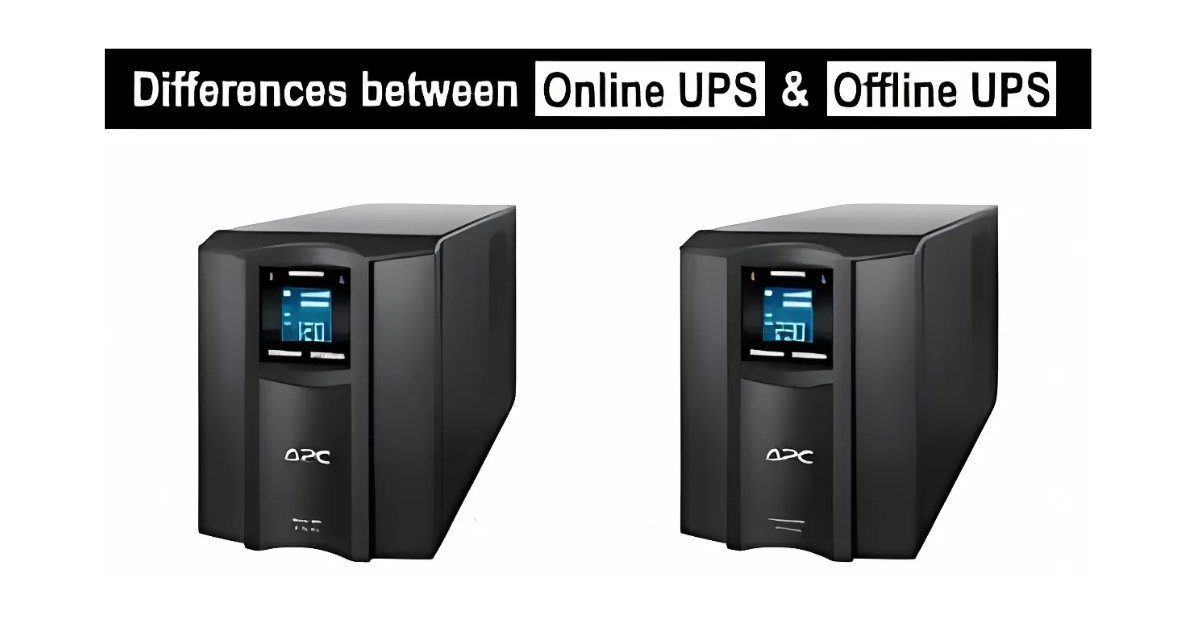The main difference between an online UPS (Uninterruptible Power Supply) and an offline UPS lies in how they provide backup power and manage power interruptions. Here’s a breakdown of their key differences:
1. Power Supply Mode:
- Online UPS: The online UPS continuously provides power to the connected load from its inverter. The input AC power is constantly fed into the UPS, where it is rectified to DC, and then inverted back to AC to supply the load. In this mode, the load is always supplied with clean, conditioned power.
- Offline UPS: In an offline UPS, the connected load is powered directly by the incoming AC utility power when it’s available. The UPS only switches to battery power during a power outage or when there is a power fluctuation (such as a voltage drop or spike). The transfer to battery power is typically within milliseconds.
2. Switching Time:
- Online UPS: There is no switching time in an online UPS because the inverter is always supplying power to the load, even when the main AC power is functioning. This ensures no interruption in the supply of power.
- Offline UPS: There is a brief switching time (typically 5-10 milliseconds) between the time the utility power is lost and the time the UPS switches to battery power. While this switching time is generally fast, it can be enough to cause a slight interruption in the power supply, which might be critical for sensitive devices.
3. Power Conditioning:
- Online UPS: It provides continuous power conditioning, filtering, and regulation. This ensures the output power is clean, stable, and free from fluctuations, surges, or harmonics.
- Offline UPS: The offline UPS does not actively condition the power when the utility supply is available. It only provides power conditioning when switching to battery mode during a power failure.
4. Efficiency:
- Online UPS: The online UPS typically consumes more energy because it continuously operates its inverter and rectifier, even when the utility power is stable. This results in lower overall efficiency compared to offline UPS systems.
- Offline UPS: The offline UPS is more energy-efficient in normal operation because it directly passes the utility power to the load without constantly running the inverter. It only switches to the inverter when there is a power issue, resulting in higher efficiency under normal conditions.
5. Cost:
- Online UPS: Online UPS systems tend to be more expensive due to the continuous operation of the inverter and rectifier, and their additional components for power conditioning and filtering.
- Offline UPS: Offline UPS systems are typically more affordable because they do not continuously run the inverter and are simpler in design.
6. Complexity and Size:
- Online UPS: Online UPS systems are larger, more complex, and require more space due to the presence of additional components like the inverter and rectifier. They are used in environments where power quality and zero downtime are critical.
- Offline UPS: Offline UPS systems are smaller and simpler in design, making them more suitable for personal use or small businesses where a brief interruption in power is acceptable.
7. Applications:
- Online UPS: Online UPS systems are used in critical applications where power quality is important, such as in data centers, hospitals, telecommunication systems, and industries that require uninterrupted power without fluctuations or interruptions.
- Offline UPS: Offline UPS systems are typically used for less critical applications, such as for home appliances, personal computers, small businesses, or non-essential equipment that can tolerate brief power interruptions.
Conclusion:
- Online UPS is ideal for environments that require uninterrupted, high-quality power, and where even brief interruptions can cause harm.
- Offline UPS is more suitable for home use or less critical systems where a short interruption in power won’t cause significant issues.
Hashtags
#OnlineUPS #OfflineUPS #TypesOfUPS #UPSSystems #PowerBackupSolutions #UninterruptiblePowerSupply #OnlineUPSFeatures #ContinuousPowerProtection #DoubleConversionUPS #FullTimePowerSupply #ZeroTransferTimeUPS #ConstantVoltageRegulation #OnlineUPSAdvantages #UninterruptedPowerOnlineUPS #OfflineUPSFeatures #StandbyPowerSupply #LowCostUPS #BatteryBackupStandby #PowerBackupOnOutage #BasicPowerProtection #OfflineUPSAdvantages #OfflineUPSForHome #OnlineUPSEfficiency #OfflineUPSEfficiency #PowerUsageOnlineUPS














